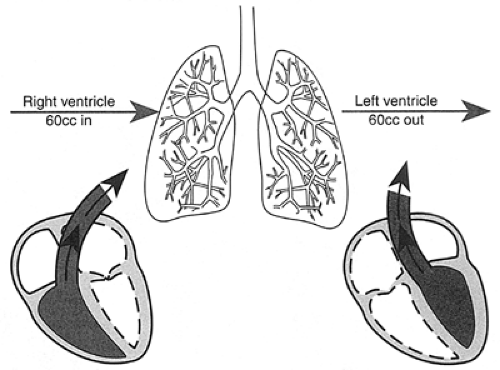Heart Failure
Before you consider the failure of a system you have to be sure you know how it works. Try putting together everything you’ve learned so far.
Imagine you were viewing a functioning model of a human, made of glass so that you could observe everything happening inside. You’d see dark blood rushing through the veins, all over the body, until those veins came together like many streams combining into two rivers—the great superior and inferior cavernous veins (superior and inferior vena cava). You’d see the heart relaxing, pulling that blood into the right ventricle, and then contracting, pumping it out to the lungs. You’d see the blood turn from dark red to bright red in the lungs as it picks up oxygen. Then you’d see the left heart pull this bright red blood out of the lungs and pump it into the body. With each beat, the right heart pumps exactly the same amount of blood into the lungs that theleft heart pumps out (Fig. 6-1).
The valves swing open just in time to permit the rush of blood to the next chamber, or, in other cases, to permit the flow of blood out of the right heart to the lungs and out of the left heart to the body. They snap shut just in time to prevent a backflow or leakage of blood back into the chamber it just left.
You would notice that the motion of blood through the body is very swift: about 6 quarts of blood move completely through the body from the left heart out through the arteries and back to the right heart through the veins in less than a minute. Everything is in a taut, precise balance, synchronized down to a fraction of a drop of blood and a thousandth of a second.
What if something goes wrong?
Left Heart Failure
To take the simplest example, what if something weakens the left ventricle so that it pumps a little less blood out of the lungs with each beat than the right ventricle pumps in (Fig. 6-2)? This could happen for many reasons—weakening of the heart muscle, a leaky valve, excessively high blood pressure. Imagine that the difference is as little as a drop and try some simple arithmetic to see what happens.
 FIGURE 6-1 Normally the right ventricle pumps the same amount of blood into the lungs with each beat that the left ventricle pumps out.
Stay updated, free articles. Join our Telegram channel
Full access? Get Clinical Tree
 Get Clinical Tree app for offline access
Get Clinical Tree app for offline access

|